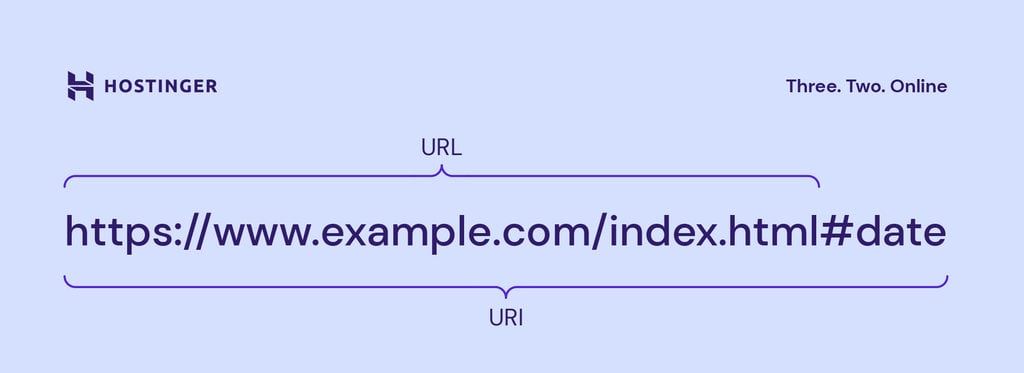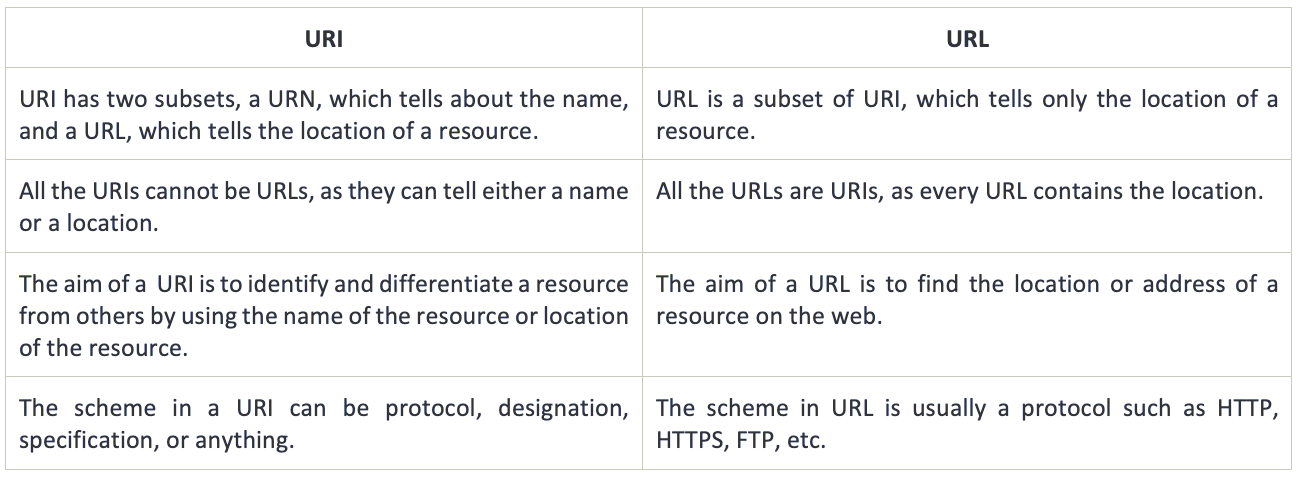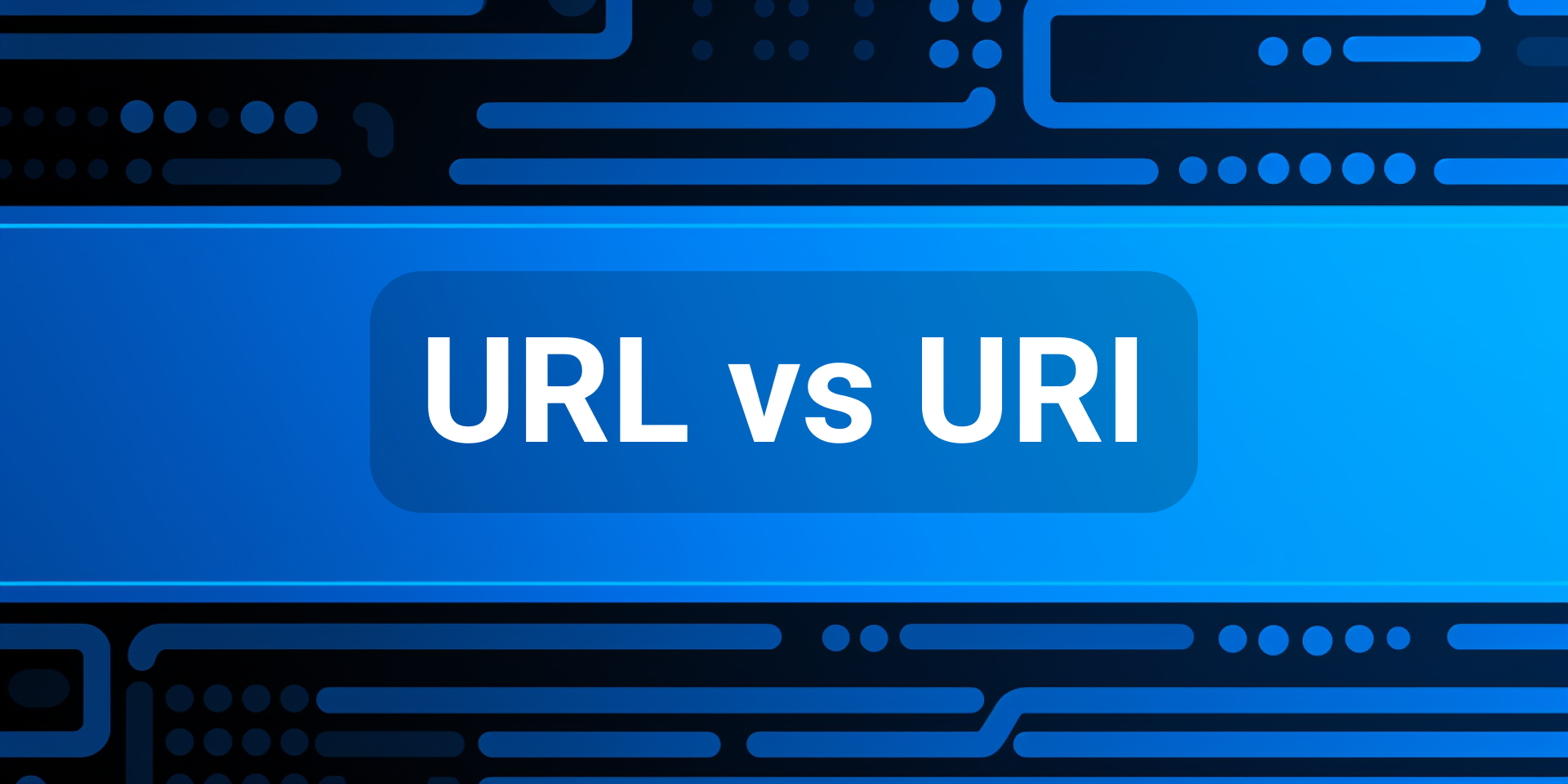Understanding the difference between a URI URL can be confusing. Both terms are often used interchangeably, but they are not the same.
When browsing the internet, you encounter both URIs and URLs. Knowing the difference can help you better understand how web addresses work. A URI (Uniform Resource Identifier) is a string of characters used to identify a resource. A URL (Uniform Resource Locator), on the other hand, is a type of URI that specifies where a resource is located.
This distinction is important for web development and internet navigation. Let’s dive deeper into what sets them apart and why it matters.

Credit: www.hostinger.com
Introduction To Uri And Url
The digital world relies on specific identifiers to locate resources. Two key terms you may encounter are URI and URL. These acronyms may seem confusing, but they play a crucial role in web technology. Understanding their differences helps you navigate and utilize the web more effectively.
Basic Definitions
URI stands for Uniform Resource Identifier. It is a string of characters used to identify a resource on the internet.
URL stands for Uniform Resource Locator. It is a specific type of URI that not only identifies a resource but also provides a means to locate it.
In simpler terms, all URLs are URIs, but not all URIs are URLs.
Importance In Web Technology
URIs and URLs are foundational to web technology. They allow web browsers and servers to communicate and share information.
| Aspect | URI | URL |
|---|---|---|
| Function | Identifies a resource | Identifies and locates a resource |
| Examples | ISBN for books, DOI for articles | Web addresses like https://www.example.com |
URIs provide a way to identify resources like books and articles. URLs help you access web pages and online content. Without them, the internet would be a chaotic place. These identifiers make the web organized and navigable.
Understanding the difference between URI and URL enhances your web literacy. It helps you better manage and access online resources. Next time you see a web address, you’ll know its role in the vast digital landscape.

Credit: levelup.gitconnected.com
Components Of A Uri
A URI (Uniform Resource Identifier) is a string of characters used to identify a resource on the internet. Understanding the components of a URI helps in decoding how different parts of an internet address work together. Let’s break down each component of a URI.
Scheme
The scheme is the first part of a URI. It specifies the protocol used to access the resource. Common schemes include http, https, ftp, and mailto. For example, in the URI https://www.example.com, “https” is the scheme.
Authority
The authority component follows the scheme, starting with //. It typically includes the domain name and may also include the port number. For instance, in the URI https://www.example.com:8080, “www.example.com:8080” is the authority.
Path
The path specifies the exact location of the resource within the server. It usually follows the authority and starts with a /. An example would be /about/us in the URI https://www.example.com/about/us.
Query
The query component provides additional parameters for the resource. It starts with a ? and includes key-value pairs separated by &. For example, in the URI https://www.example.com/search?q=uri, “q=uri” is the query.
Fragment
The fragment identifies a specific section within the resource. It starts with a #. For instance, in the URI https://www.example.com/page#section1, “section1” is the fragment.
Components Of A Url
Understanding the components of a URL is crucial for web navigation. A URL (Uniform Resource Locator) specifies the address of a resource on the internet. Let’s break down the various parts of a URL to grasp its structure better.
Protocol
The protocol indicates the method used to fetch the resource. Common protocols include HTTP, HTTPS, FTP, and more. For example, HTTPS ensures secure communication between the browser and the server.
Domain
The domain is the main part of the URL. It identifies the website. For instance, in “https://example.com”, “example.com” is the domain.
Port
The port specifies the channel through which data is sent. Typically, it’s not shown in URLs. The default port for HTTP is 80, and for HTTPS, it’s 443.
Path
The path directs to a specific resource within the website. It follows the domain. For instance, in “https://example.com/about”, “about” is the path.
Query
The query provides additional parameters for the resource. It starts with a question mark (?). For example, in “https://example.com/search?q=URL”, “q=URL” is the query.
Fragment
The fragment points to a specific part within the resource. It starts with a hash (#). For example, in “https://example.com/page#section1”, “section1” is the fragment.
Key Differences
Understanding the key differences between a URI and a URL can help navigate the web more effectively. Both are terms used in web development, but they serve distinct purposes. Let’s break down their differences by looking at their structure, usage, and examples.
Structure
The structure of a URI and a URL can be broken down into specific components. Here’s a table to illustrate:
| Component | URI | URL |
|---|---|---|
| Scheme | Yes | Yes |
| Authority | Optional | Yes |
| Path | Yes | Yes |
| Query | Optional | Optional |
| Fragment | Optional | Optional |
A URI can be a name, locator, or both. A URL is a specific type of URI that includes a network location.
Usage
URIs are used to identify resources. They can name or locate resources. URLs are used to specify the exact location of a resource on the web.
- URI: Identifies a resource.
- URL: Locates a resource on the web.
Both URIs and URLs play roles in accessing web resources. URLs are more common in everyday web browsing.
Examples
Let’s look at some examples to understand the differences better.
- URI Example:
urn:isbn:0451450523 - URL Example:
https://www.example.com/page
The URI example shows an identifier for a book. The URL example shows a specific web address.
When To Use Uri
Understanding when to use a URI is crucial for developers and webmasters. A URI, or Uniform Resource Identifier, is a string used to identify a resource. It can be either a URL (Uniform Resource Locator) or a URN (Uniform Resource Name). Knowing the right scenarios for using a URI can enhance your web projects and ensure proper resource identification.
General Use Cases
- Web Development: URIs are fundamental in web development. They identify resources such as web pages, images, or files.
- APIs: URIs are used to access different endpoints in APIs. This enables communication between different systems.
- Database management: URIs help in identifying and accessing specific databases or records within databases.
- File Systems: URIs can be used to locate and access files in a file system.
Advantages
URIs provide several advantages that make them indispensable:
- Uniformity: They offer a standardized way to identify resources, ensuring consistency.
- Flexibility: URIs can represent various types of resources, making them versatile.
- Interoperability: They enable different systems to communicate and share resources effectively.
- Scalability: URIs can be used in small projects as well as large, complex systems.
By understanding these use cases and advantages, you can effectively incorporate URIs into your projects and ensure seamless resource identification and access.
When To Use Url
Understanding the difference between URI and URL is crucial. This knowledge helps you use them correctly. In this section, we will focus on when to use a URL.
General Use Cases
URLs are essential in web development and everyday web use. They are the standard for locating web resources. Here are some common use cases:
- Accessing websites: URLs are used to visit websites. Example:
https://www.example.com - Linking to resources: URLs link to images, videos, and documents. Example:
https://www.example.com/image.jpg - API endpoints: URLs specify API endpoints. Example:
https://api.example.com/v1/users - Email links: URLs create mailto links for emails. Example:
mailto:info@example.com
Advantages
Using URLs has several advantages:
- Easy to understand: URLs are simple and user-friendly.
- Widely supported: All web browsers and applications support URLs.
- Standardized format: URLs follow a standard format, making them reliable.
- SEO benefits: Well-structured URLs improve search engine ranking.
URLs are an integral part of the web. They help users and developers navigate and link to resources efficiently.
Common Misconceptions
Many people confuse URI and URL. This confusion often leads to errors in understanding web technologies. Let’s clear up some common misconceptions.
Interchangeability
One common belief is that URI and URL are interchangeable. This is not true. A URI is a broader concept. It identifies a resource. A URL specifies the location of a resource. All URLs are URIs, but not all URIs are URLs.
Technical Nuances
Another misconception involves the technical details. Some think URIs and URLs have the same structure. This is false. Below is a table showing the differences:
| Aspect | URI | URL |
|---|---|---|
| Definition | Identifies a resource | Locates a resource |
| Example | urn:isbn:0451450523 | https://www.example.com |
People often overlook these technical nuances. This can lead to confusion in web development.
Understanding these differences can make a big impact. It can help you use the correct term in the right context. This helps in better communication and less confusion.

Credit: www.domain.com
Frequently Asked Questions
What Is A Uri?
A URI is a Uniform Resource Identifier. It identifies a resource on the internet.
What Is A Url?
A URL is a Uniform Resource Locator. It gives the address to access a resource.
How Are Uri And Url Different?
A URI identifies a resource. A URL provides the path to access it.
Can A Uri Be A Url?
Yes, a URL is a type of URI. But not all URIs are URLs.
Why Is Understanding Uri And Url Important?
It helps in web development and understanding how resources are accessed online.
Conclusion
Understanding the difference between URI and URL is crucial. URIs are identifiers. URLs are a type of URI. They locate resources on the web. This knowledge helps you use the correct term. It ensures clear communication. Keep these distinctions in mind.
Your web development skills will improve. Clear communication benefits everyone. So, practice using these terms correctly. It makes a big difference.
